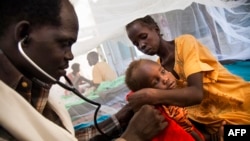A simple blood test is highly effective at identifying children infected with tuberculosis so they can be treated before it progresses to a life-threatening disease, according to research by scientists who say it is often difficult to diagnose TB in children.
One of the biggest challenges in the global war on TB is identifying people early so they can be treated before the disease becomes full-blown and potentially fatal.
Finding TB in young children, in particular, poses a hurdle because youngsters often can’t produce a sputum sample necessary to diagnose the disease.
The other problem, according to infectious disease specialist Jason Andrews of Stanford University, is children’s infections often settle in their kidney, spine or brain. Unlike TB infections in the lungs, a sputum test cannot diagnose infection in other organs.
'Vast majority can be cured'
“If you find them early and treat them, the vast majority — close to 100 percent — can be cured,” Andrews said. “For the preventive therapy [in children with latent infection], a single antibiotic can be given that has very good ability to prevent against going on to develop active disease."
Andrews and his colleagues conducted a study on the use of a blood test to diagnose children at risk of developing TB and found it highly effective.
While the test, called QuantiFERON, is sometimes used in adults, the World Health Organization (WHO) does not recommend it for children.
The researchers analyzed the data from a clinical trial of an experimental TB vaccine trial in South Africa, just outside Cape Town.
The vaccine turned out to be a flop, but investigators were curious about how well the blood test performed in diagnosing latent TB in young children — those at highest risk of developing an active infection.
2,500 children tested
The study involved approximately 2,500 healthy, HIV-negative babies and children.
At the start, none was infected with the TB bacterium. The test was repeated one year later, to check for the development of an infection.
At that point, 172 of the children tested positive for TB, and 30 were already being treated. Researchers then looked at data on the other 142 kids who had not yet developed active disease.
Testing them at the two-year mark, they found that those children with the highest levels of a blood biomarker called interferon gamma had a 40-fold increase in the risk of developing active tuberculosis.
“When we saw the data in children, we were just astounded by the exceptional predictive value that it had,” Andrews said.
The study was published in the journal The Lancet Respiratory Medicine.
Based on the findings, Andrews would like to see the WHO change its recommendation to include the use of the blood test in children.
Powerful killer
“Our hope is that this could represent one more tool for both diagnosis of TB in children, as well as predicting kids who are at highest risk so we can prevent that disease," he said.
More than 10 million people fall ill with TB every year, according to the World Health Organization. The disease killed 1.8 million people in 2015; 170,000 of them were children.
While Andrews said only 5 to 10 percent of infected adults will go on to develop active TB, children are particularly vulnerable, with 20 percent who are infected with the bacterium eventually developing the ailment.
Children often contract TB from an infected parent or caretaker.
Andrews said early diagnosis using the blood test and prompt treatment can be a lifesaver for youngsters at high risk of developing tuberculosis.







